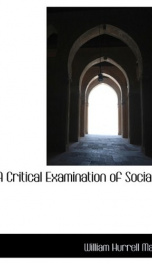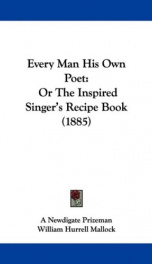Mallock William Hurrell

William Hurrell Mallock (7 February 1849 – 2 April 1923) was an English author. He was educated privately and then at Balliol College, Oxford. He won the Newdigate prize in 1872 and took a second class in the final classical schools in 1874, securing his Bachelor of Arts degree from Oxford University. He attracted considerable attention by his satirical novel The New Republic (1878),[1] in which he introduced characters easily recognized as such prominent individuals as Matthew Arnold, Thomas Carlyle, and Thomas Henry Huxley. His keen logic and gift for acute exposition and criticism were displayed in later years both in fiction and in controversial works. In a series of books dealing with religious questions he insisted on dogma as the basis of religion and on the impossibility of founding religion on purely scientific data. In Is Life Worth Living? (1879)[2] and The New Paul and Virginia (1878) he attacked Positivist theories, and in a volume on the intellectual position of the Church of England, Doctrine and Doctrinal Disruption (1900), he advocated the necessity of a strictly defined creed. Later volumes on similar topics were Religion as a Credible Doctrine (1903) and The Reconstruction of Belief (1905). He also authored articles, one in particular directed against Huxley's Agnosticism, entitled "'Cowardly Agnosticism' A Word with Professor Huxley," in the April 1889 issue of The Fortnightly Review.[3] He published several brilliant works on economics, directed against radical and socialist theories: Social Equality (1882), Property and Progress (1884), Labor and the Popular Welfare (1893), Classes and Masses (1896), Aristocracy and Evolution (1898), and A Critical Examination of Socialism (1908).[4] Among his anti-socialist works should be classed his novel, The Old Order Changes (1886). His other novels include A Romance of the Nineteenth Century (1881), A Human Document (1892), The Heart of Life (1895), and The Veil of the Temple (1904). He published a volume of Poems in 1880. His 1883 book Lucretius included some verse translations from the Roman poet,[5] which he followed with Lucretius on Life and Death in 1900,[6] a book of verse paraphrases in a style modeled after the Rubaiyat of Omar Khayyam by Edward FitzGerald. (A second edition was issued in 1910).[7] Ironically, this latter work came to be highly regarded by freethinkers and other religious skeptics. Corliss Lamont includes portions of the third canto in his A Humanist Funeral Service. Mallock himself, in his introduction, seems to be offering it, somewhat condescendingly, for the use of such non-Christians when he writes: Artist Tom Phillips used Mallock's A Human Document as the basis for his project A Humument, where he took a copy of the novel and constructed a work of art using its pages.[8]
do you like this author?
What readers are saying
What do you think? Write your own comment on this book!
write a commentWhat readers are saying
What do you think? Write your own comment on this author!
write a commentBook list

The New Paul and VirginiaPositivism on an Island
Series:
Unknown
Year:
Unknown
Raiting:
2.5/5
Show more
add to favoritesadd In favorites

Every Man His Own PoetOr,The Inspired Singer's Recipe Book
Series:
Unknown
Year:
Unknown
Raiting:
3.5/5
Show more
add to favoritesadd In favorites
Book list

The New Paul and VirginiaPositivism on an Island
Series:
Unknown
Year:
Unknown
Raiting:
2.5/5
Show more
add to favoritesadd In favorites

Every Man His Own PoetOr,The Inspired Singer's Recipe Book
Series:
Unknown
Year:
Unknown
Raiting:
3.5/5
Show more
add to favoritesadd In favorites

Is Life Worth Living?
Series:
Unknown
Year:
Unknown
Raiting:
2.5/5
Purchase of this book includes free trial access to www.million-books.com where you can read more than a million books for free. This is an OCR edition with typos. Excerpt from book: eral reverence with which life is at present regarded rest in any degree upon any similar misconception ? And if so, to what extent does it ? Will it fall to pieces before the breath of a larger knowledge ? or has it that firm foundation in fact that will enable it to survive in spite of all enlightenment, and perhaps even to increase in consequence of it'( Such is the outline of the question I propose to deal with. I will now show why it is so pressing, and why, in the present crisis of thought, it is so needful that it should be dealt with. The first impression it produces, as I have said, is that it is superfluous. Our belief in life seems to rest on too wide an experience for us to entertain any genuine doubt of the truth of it. But this first impression does not go for much. It is a mere superficial thing, and will wear off immediately. We have but to remember that a belief that was supposed to rest on an equally wide basisthe belief in God, and in a supernatural orderhas in these days, not been questioned only, but has been to a great degree, successfully annihilated. The only philosophy that belongs to the present age, the only philosophy that is a really new agent in progress, has declared this belief to be a dissolving dream of the past. And this belief, as we shall see presently, is, amongst civilized men at least, far older than the belief in life ; it has been far more widely spread, and experience has been held to confirm it with an equal certainty. If this then is inevitably disintegrated by the action of a widening knowledge, it cannot be taken for granted that the belief in life will not fare likewise. It may do so; but until we have examined it more closely we cannot be certain that it will. Common consent and experience, until they are analysed, are fallacio...
Show more
add to favoritesadd In favorites

A Critical Examination of Socialism
Series:
Unknown
Year:
Unknown
Raiting:
3/5
Purchase of this book includes free trial access to www.million-books.com where you can read more than a million books for free. This is an OCR edition with typos. Excerpt from book: CHAPTER IV THE ERRORS OF MARX, CONTINUED. CAPITAL AS THE IMPLEMENT OF ABILITY Two kinds of human effort being thus involved in modern production, it is necessary for all purposes of intelligible discussion to distinguish them by different names. The word "labor" being appropriated by common custom to the manual task-work of the majority, some other technical word must be found to designate the directive faculties as applied to productive industry. The word here chosen, in default of a better, is "ability." Ability, then, being the faculty which directs labor, by what means does it give effect to its directions ? It gives effect to its directions by means of its control of capital, in the form of wage-capital. Ability, using wage-capital as its implement of direction, gives rise to fixed capital, in the form of the elaborate implements of modern production, which are the material embodiments of the knowledge, ingenuity, and energy of the highest minds. The human activities and faculties, then, which are involved in the production of modern wealth, are not, as Marx saysand as the orthodox economists said, whom he rightly calls his masters, and as their followers still sayof one kindnamely, those embodied in the individual task-work of the individual, to which Marx, Ricardo, and Mill alikegive the name of "labor"; they are of two kinds. And this, indeed, the earlier economists recognized, as we may see by Mill's casual admission that the progress of industrial effort depends before all things on thought and the advance of knowledge. But they recognized the fact in a general way only. How thought and knowledge affected the industrial process they made no attempt to explain, otherwise than by comprehending them on occasion under the common name of labor, which t... --This text refers to an alternate Paperback edition.
Show more
add to favoritesadd In favorites
What readers are saying
What do you think? Write your own comment on this author!
write a commentif you like Mallock William Hurrell try:
readers also enjoyed
What readers are saying
What do you think? Write your own comment on this author!
write a commentGenre
if you like Mallock William Hurrell try:
readers also enjoyed
Do you want to exchange books? It’s EASY!
Get registered and find other users who want to give their favourite books to good hands!


